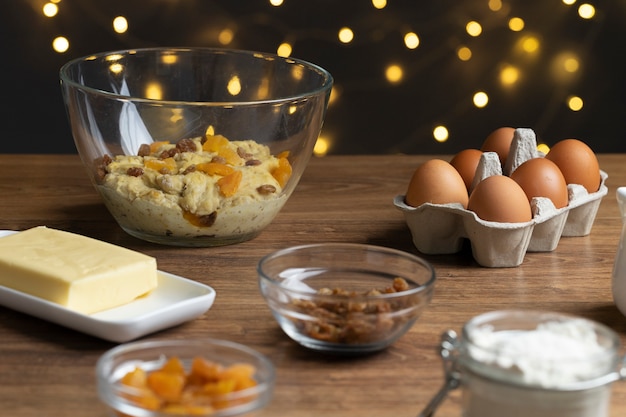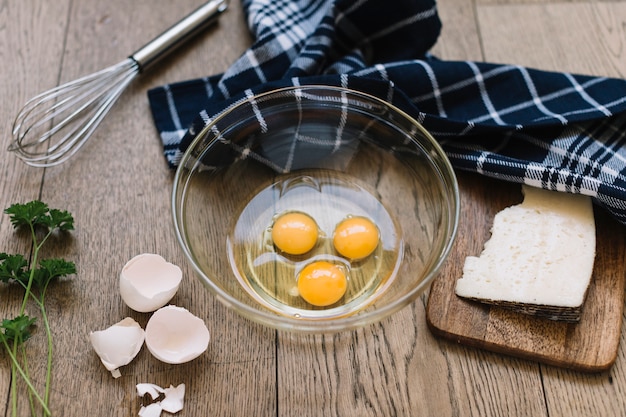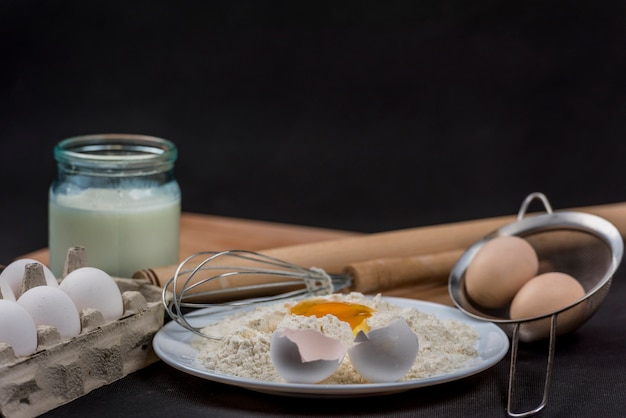Let’s face it, hard-boiled eggs are a kitchen staple. They're incredibly versatile, perfect for everything from a quick breakfast to a fancy salad. But, let’s be honest, mastering the art of the perfect hard-boiled egg can feel like a culinary hurdle. You know the feeling – that dreaded green ring around the yolk that screams "overcooked" or the rubbery texture that makes you want to throw the whole thing in the bin.
Don't worry, my fellow egg-lovers! I've been there, and I've learned a thing or two along the way. This guide will take you on a deep dive into the world of hard-boiled eggs, uncovering the secrets to achieving that perfect, golden yolk and a smooth, firm texture every time. We'll cover everything from the best techniques to the most common pitfalls, and I'll even share some of my personal tips and tricks that I've picked up over the years.
So, grab your trusty saucepan and get ready to learn how to master the art of the perfect hard-boiled egg. Let's get started!
(Part 1) The Basics of boiling eggs

Before we get into the more advanced techniques, let's start with the foundation. Hard-boiling eggs is a simple process, but even the simplest things can go wrong if you don't have the right technique.
1. choosing the right eggs: It's Not Just About Size
The age of the egg can actually make a difference in the final outcome. fresh eggs, those that have been laid within the past few days, have a tighter, more delicate protein structure. This makes them more likely to crack and have a less desirable texture after cooking. I find that eggs that are a few days old work best for hard-boiling, giving you a firmer yolk and less chance of cracking. Older eggs, however, can start to become a bit "gassy," so try to use eggs that are no more than a week old for optimal results.
When it comes to size, medium or large eggs are generally the best choice for hard-boiling. Smaller eggs tend to cook faster, which can lead to a harder, rubbery yolk if you're not careful. Larger eggs, however, can take a bit longer to cook through.
2. Prepping the Eggs: A Gentle Approach
Once you've chosen your eggs, it’s time for a little prep. First, give them a good wash to remove any dirt or debris. Then, gently tap the larger end of the egg with the back of a spoon to create a tiny crack in the shell. This little trick helps prevent the eggs from cracking during cooking and allows steam to escape, making for a smoother texture.
This gentle tapping technique is key. You want to create a small, hairline crack, not a large hole. Too big of a crack can lead to the egg white leaking out during cooking.
3. Boil the Eggs: Low and Slow for a Smooth Finish
Now, let's get to the boiling part! Grab your saucepan and fill it with enough cold water to cover the eggs by at least an inch. Place the eggs in the pan and bring the water to a boil over a medium heat. Once the water is boiling, reduce the heat to a low simmer and cover the pan with a lid. This is crucial for a smooth, even cook. The low simmer allows for a gentle and gradual cooking process, ensuring that the yolk cooks evenly and doesn't turn green.
The idea here is to cook the eggs slowly and gently, preventing the yolk from overcooking and becoming hard. Think of it like simmering a delicate sauce – you want to cook it slowly so it doesn’t burn or become tough.
(Part 2) Timing is Key: Mastering the Perfect Hard-Boiled Egg

The key to perfectly cooked hard-boiled eggs is getting the timing just right. Too little time and you'll end up with a runny yolk, too much time and you’ll have a hard, green ring around the yolk. The timing depends on the size of your eggs, but here are some general guidelines:
1. Small Eggs:
Hard-boiled: 6-7 minutesMedium-boiled: 5-6 minutesSoft-boiled: 3-4 minutes
2. Medium Eggs:
Hard-boiled: 8-9 minutesMedium-boiled: 7-8 minutesSoft-boiled: 4-5 minutes
3. Large Eggs:
Hard-boiled: 10-11 minutesMedium-boiled: 9-10 minutesSoft-boiled: 5-6 minutes
Remember, these are just general guidelines. You’ll want to experiment a bit to find the perfect cooking time for your preference and the size of your eggs. I recommend starting with the lower end of the time range and adjusting as needed.
It’s important to note that the cooking time for hard-boiled eggs can vary depending on the altitude. At higher altitudes, water boils at a lower temperature, so you may need to adjust the cooking time slightly. If you're cooking at a higher altitude, I recommend adding an extra minute or two to the cooking time.
(Part 3) Cooling Down the Eggs: A Crucial Step

Once your eggs are done cooking, it’s time to cool them down. This is a crucial step in preventing that green ring around the yolk and ensuring a smooth texture. I like to use an ice bath for this. Simply drain the hot water from the pan and immediately place the eggs in a bowl of ice water. Let them sit in the ice bath for 5-10 minutes, until they’re completely cool.
The rapid cooling process stops the cooking process and helps prevent the yolk from becoming too dry. It also makes the eggs easier to peel.
If you don't have ice on hand, you can also cool the eggs by running cold water over them. Just make sure the water is cold enough to stop the cooking process quickly.
(Part 4) The Art of Peeling: Making It Easy
peeling hard-boiled eggs can be a bit of a challenge, but it doesn’t have to be a struggle. Here are a few tricks to make the process easier:
1. The Tap Technique:
Give the egg a gentle tap on the side with the back of a spoon to create a small crack. This helps loosen the shell and makes peeling easier.
2. The Rolling Technique:
Roll the egg gently on a flat surface, pressing down with your hand. This helps to crack the shell without damaging the egg white.
3. The Water Trick:
Place the egg in a bowl of cold water and let it sit for a few minutes. This helps loosen the shell. Then, gently tap the egg on a flat surface to crack it.
4. The Peeling Technique:
Once the shell is cracked, start peeling from the larger end of the egg. This is where the air pocket is located, and it’s usually the easiest place to start. Peel gently, working your way down to the other end. If the shell is stubborn, try using your thumb and forefinger to gently roll the shell off.
If you find that the egg white sticks to the shell, it’s a sign that the egg was overcooked. You can try peeling it under cold running water, as this can help loosen the shell and prevent sticking.
Another trick I’ve found helpful is to peel the eggs under cold running water. The cold water helps to loosen the shell and make peeling easier.
(Part 5) Preventing the Green Ring: A Common Problem
That dreaded green ring around the yolk – it's a classic hard-boiled egg nightmare. But what causes it? And how do we prevent it? Well, it’s all about the chemistry of the egg. The iron in the egg yolk reacts with the sulfur in the egg white during cooking, creating a green compound called ferrous sulfide.
The good news is, there are several ways to prevent this from happening:
1. Add Vinegar to the Water:
Adding a tablespoon of vinegar to the boiling water helps to lower the pH of the water, making it more acidic and preventing the green ring from forming. The vinegar also helps to firm up the egg white, making it less likely to stick to the shell.
2. Cool the Eggs Quickly:
Remember that ice bath we talked about? Cooling the eggs down quickly is key to preventing the green ring. The rapid cooling stops the cooking process and prevents the iron and sulfur from reacting.
3. Use Older Eggs:
As mentioned earlier, older eggs tend to have a firmer protein structure, making them less likely to develop a green ring. This is because the yolk is less likely to react with the white during cooking.
It's also worth noting that using a pressure cooker can help to prevent the green ring. The high pressure and steam in the pressure cooker help to cook the eggs quickly and evenly, reducing the risk of the iron and sulfur reacting.
(Part 6) Beyond Basic: Adding Flavor and Variety
Okay, so you’ve mastered the art of the perfect hard-boiled egg. But why stop there? There are so many ways to add flavor and variety to your hard-boiled eggs. Here are a few ideas:
1. Spice It Up:
Add a pinch of your favorite spices to the boiling water. Paprika, cumin, turmeric, cayenne pepper – the possibilities are endless. This infuses the eggs with a subtle flavor and adds a vibrant color.
For a more intense flavor, you can also try adding spices to the egg yolk after peeling, such as smoked paprika or chili powder.
2. Get Creative with Herbs:
A sprig of rosemary, thyme, or bay leaf added to the boiling water will lend a delicate herbal aroma to the eggs. You can also experiment with other herbs, such as dill, oregano, or basil.
3. The Pickled Egg Twist:
For a truly unique flavor, try pickling your hard-boiled eggs. Soak the peeled eggs in a brine of vinegar, spices, and herbs for several days. The result is a tangy and delicious treat.
To make your own pickled eggs, simply combine equal parts white vinegar and water in a jar. Add your favorite spices, such as black peppercorns, mustard seeds, or cloves. Add the peeled hard-boiled eggs to the jar and refrigerate for at least 24 hours. The longer you let the eggs pickle, the stronger the flavor will be.
(Part 7) Serving Up Your Hard-Boiled Egg Masterpiece
Now that you’ve got your perfect hard-boiled eggs, it’s time to showcase them! There are so many ways to serve these versatile little beauties.
1. The Classic Deviled Egg:
A classic for a reason! deviled eggs are a simple yet elegant appetizer or side dish. Simply chop the eggs, mash them with mayonnaise, mustard, and seasonings, and pipe them back into the egg whites.
For a twist on the classic deviled egg, try adding a dollop of sour cream, a sprinkle of chives, or a pinch of smoked paprika.
2. Salad Star:
Hard-boiled eggs add texture and protein to any salad. Chop them and add them to a green salad, or slice them for a more elegant presentation.
Try adding hard-boiled eggs to a salad with a vinaigrette dressing for a delicious and nutritious meal. The eggs will add a creamy texture and protein to the salad.
3. Breakfast Bites:
Hard-boiled eggs are a great way to start your day. Slice them and add them to toast with avocado or smoked salmon, or sprinkle them over a bowl of oatmeal.
Hard-boiled eggs are also a great addition to breakfast sandwiches. Simply slice the eggs and add them to your favorite breakfast sandwich fillings, such as cheese, bacon, or sausage.
4. Sandwiches and Wraps:
Hard-boiled eggs are a delicious addition to sandwiches and wraps. Slice them and add them to your favorite fillings for a protein boost and a satisfying crunch.
Try adding hard-boiled eggs to a tuna salad sandwich or a chicken salad wrap for a more substantial meal.
5. Get Creative with Garnish:
Don’t be afraid to get creative with garnishes for your hard-boiled eggs. A sprinkle of fresh herbs, a dollop of sour cream, or a drizzle of hot sauce can elevate your dish from ordinary to extraordinary.
For a more elegant presentation, try arranging the hard-boiled eggs on a platter with a bed of greens, a sprinkle of fresh herbs, and a drizzle of olive oil.
(Part 8) Hard-Boiled Egg Hacks: Tips from a Seasoned Egg-Lover
Here are a few tips and tricks I’ve picked up along the way that make the process of hard-boiling eggs a little bit easier and a lot more enjoyable:
?? Instead of adding vinegar, try adding a pinch of baking soda to the boiling water. This helps to prevent cracking and keeps the egg white from sticking to the shell.
?? Want to avoid peeling altogether? Try using a pressure cooker. The steam in the pressure cooker creates a pressure difference that helps to loosen the shell. Simply cook the eggs for 5-7 minutes in the pressure cooker and then immediately transfer them to an ice bath. The shells will practically fall off.
?? If you’re making deviled eggs, try adding a tablespoon of Dijon mustard to the mashed egg yolk for a punch of flavor.
?? For a fun and festive touch, dye your hard-boiled eggs with food coloring. This is a great activity for kids or for adding a pop of color to your next gathering.
FAQs
Here are some frequently asked questions about hard-boiled eggs:
1. Why do hard-boiled eggs sometimes have a green ring around the yolk?
As mentioned earlier, the green ring is caused by the reaction between the iron in the yolk and the sulfur in the egg white. This reaction is more likely to occur when the eggs are overcooked or not cooled down quickly enough.
2. How long do hard-boiled eggs last in the refrigerator?
Hard-boiled eggs can last in the refrigerator for up to a week. Store them in a covered container or airtight bag.
3. How can I tell if a hard-boiled egg is still good?
If the egg white is clear and the yolk is firm, the egg is still good. If the egg white is cloudy or the yolk is loose, it’s best to discard the egg.
4. Can I freeze hard-boiled eggs?
It’s not recommended to freeze hard-boiled eggs. Freezing can change the texture of the egg, making it rubbery and difficult to peel. It’s best to use hard-boiled eggs within a week of cooking.
5. What are some other ways to cook eggs?
There are many other ways to cook eggs, including frying, scrambling, poaching, and making omelets. Each method offers a unique flavor and texture.
I hope this guide has inspired you to confidently tackle your next hard-boiled egg adventure! With a little practice and these tips, you’ll be able to create those perfect, golden yolk masterpieces every time. Happy boiling!
Everyone is watching

How to Cook Frozen Lobster Tails Perfectly: A Step-by-Step Guide
RecipesLobster. Just the word conjures up images of lavish meals, special occasions, and a taste of luxury. But let's...

Pigs in a Blanket Cooking Time: How Long to Bake for Perfect Results
RecipesAh, pigs in a blanket. Just the name conjures up images of those delightful little parcels of crispy pastry en...

Pork Fillet Cooking Time: How Long to Cook It Perfectly
RecipesPork fillet, or tenderloin as it's sometimes called, is a real favourite in our house. It's so versatile, and...

The Ultimate Guide to Cooking Delicious Frankfurters
RecipesLet's face it, we all love a good frankfurter. It's a classic, simple, and always satisfying. But let's be rea...

Wolf Meat Recipes: A Guide to Cooking Wild Game
RecipesLet's be honest, you don't see wolf meat at your local butcher shop every day. It's a bit of a wild card, but ...
